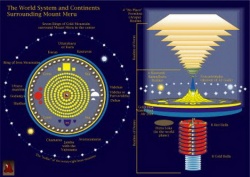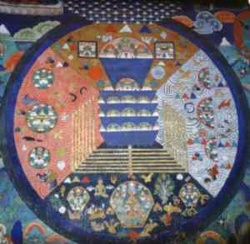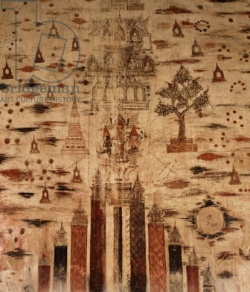Meru
Click here to see other articles relating to word Meru
Mount Meru (Sanskrit: मेरु), also called Sumeru i.e. the "Excellent Meru" and Mahameru i.e. "Great Meru", is a sacred mountain in Hindu, Jain as well as Buddhist cosmology and is considered to be the center of all the physical, metaphysical and spiritual universes.
It is also the abode of Lord Brahma and the Demi-Gods (Dev).
People of all times from around the world have stood in awe when faced with majestic mountains.
From these sublime experiences have come myths about great mountains as homes of the gods, as stairways to the heavens, as pillars of the earth.
One mountain range in particular inspired this kind of awe, wonder and devotion - the vast Himalayas.
The Tibetans and the Hindus especially held the great Himalayan mountain range as sacred.
Its grand peaks seemed to reach beyond the profane human realm and stretch up, touching the divine realm of the gods, so the Tibetans and Hindus saw the mountains as a means of transition between both the human and heavenly worlds.
The mountains were created, myth tells us, by the god Indra.
A huge herd of flying elephants had displeased him, so he punished them by cutting off their wings and they turned into the Himalayas. The mountains were important to all of the gods for they all made sacrifices there. They were especially significant to the god Shiva, however, whose paradise was on Mount Kailas and whose deep meditation upon the mountain ensured the continued existence of all things. The most sacred mountain of the whole Himalayan range though was most definitely Mount Meru.
As we have discussed, Mount Kailas is the home of the great god Shiva.
Well, Mount Kailas is an actual Himalayan mountain in the Ngari region of Tibet.
It rises 22,000 feet high from the edge of the Tibetan Plateau and is highly inaccessible.
It is Mount Kailas then that is the physical embodiment of Mount Meru for the Buddhist and Hindu peoples.
Mythical Mount Meru was thought to be the axis of the universe, sitting at the centre of the Himalayas.
Myths say that Meru rested on the hood of the coiled primeval cobra Vasuki, who, it was said, caused earthquakes when he yawned.
It was also believed that the whole world would be devoured by this ancient snake at the end of the present age, world cycle.
The Hindus and Buddhists both regarded Mount Meru as sacred for it was thought to be the centre of the cosmos and supported all of the spheres of existence, from Brahma's divine city of gold at its peak, to the seven netherworlds at its base, and especially as the source of the sacred Ganges river.
They said that Mount Meru's slopes were studded with glittering gemstones and were thick with trees heavy with delicious fruit. Its peaks were rimmed with gold and a huge lake encircled it.
The divinity of this mountain is reflected in the religious objects of worship, yantras, of these peoples for the mountain is symbolized in their conical shape. Indeed, this majestic mountain inspired much awe in those who beheld it.
How could they not think it supported the cosmos and was home to a great god?
It commanded respect in its sublime beauty and the peoples of the region responded by holding it most sacred.
The mountain is said to be 84,000 Yojan high (which is around 1,082,000 km (672,000 mi), or 85 times the Earths's diameter).
Many famous Hindu and similar Jain temples have been built as symbolic representations of this mountain.
The highest point (the finial bud) on the pyatthat, a Burmese-style multi-tiered roof, represents Mount Meru.
Mount Meru of Hindu traditions has clearly mythical aspects, being described as 84,000 Yojan high, and having the Sun along with all its planets in the Solar System revolve around it as one unit.
Geographical
The dimensions attributed to Mount Meru, all the references to it being as a part of the Cosmic Ocean, along with several statements like that the Sun along with all the planets (including Earth itself) circumbulate the mountain, make determining its location most difficult, according to most scholars.
However, a small handful number of western scholars have tried quite hard to identify Mount Meru or Sumeru with the Pamirs, north-east of Kashmir.
The Suryasiddhanta mentions that Mt Meru lies in 'the middle of the Earth' ("Bhugol-madhya") in the land of the Jambunad (Jambudvipa). Narpatijayacharyā, a 9th century text, based on mostly unpublished texts of Yāmal Tantra, mentions "Sumeruḥ Prithvī-madhye shrūyate drishyate na ('Su-meru is heard to be in the middle of the Earth, but is not seen there').
Vārāhamihira, in his Panch-siddhāntikā, claims Mt Meru to be at the North Pole (though no mountain exists there as well). Suryasiddhānt, however, mentions a Mt Meru in the middle of Earth, besides a Sumeru and a Kumeru at both the Poles.
There exist several versions of Cosmology in existing Hindu texts.
In one of them, cosmologically, the Meru mountain was also described as being surrounded by Mandrachal Mountain to the east, Supasarv Mountain to the west, Kumuda Mountain to the north and Kailash to the south.
Height
One Yojana can be taken to mean about 11.5 km (9 mi) though its magnitude seems to differ over time periods. E.g. the Earth's circumference is 3,200 Yojanas according to Vārāhamihira and slightly less so in the Āryabhatiya, but is given to be 5,026.5 Yojanas in the Suryasiddhānta.
The Matsya Purana and the Bhāgvata Purāna along with some other Hindu texts consistently give the height of 84,000 Yojanas to Mount Meru which translates into 672,000 miles or 1.082 million kilometers.
Puranic legends An attempt to depict the cosmology of the Puranas, and Mount Meru, provenance and exact date unknown
Mount Meru finds mention innumerable times in Hindu lore.
Some of the better-known legends are recounted here. Legends say that Mount Meru and the wind god Vayu were good friends.
However, the sage Narada approached Vayu and incited him to humble the mountain.
Vayu blew with full force for one full year, but Meru was shielded by Garuda with his wings (he was flying high).
However, after a year Garuda took respite for some time.
Thus the apex of the mountain was broken and it fell into the sea and created the island of Lanka.
Mount Meru was said to be the residence of King Padamja Brahma in antiquity.
The Puranas and Hindu epics, often state that Surya, i.e. the sun-God, along with all its planets and stars together as one unit, circumambulate Mount Meru every day.
This mythical mountain of gods was mentioned in Tantu Pagelaran, an Old Javanese manuscript written in Kawi language from 15th century Majapahit period.
The manuscript is describing the mythical origin of Java island, and the legend of moving some parts of mount Meru to Java.
The manuscript explained that Batara Guru (Shiva) has ordered the god Brahma and Vishnu to fill the Java island with human beings.
However at that time Java island was floating freely on the ocean, ever tumbling and always shaking.
To make the island still, the gods decided to nail the island upon the earth by moving the part of Mahameru in Jambudvipa (India) and attaching it upon Java.
The resulting mountain is Mount Sumeru, the tallest mountain of Java.
(Sanskrit: मेरु), also called Sumeru i.e. the "Excellent Meru" and Mahameru i.e. "Great Meru", is a sacred mountain in Hindu, Jain as well as Buddhist cosmology and is considered to be the center of all the physical, metaphysical and spiritual universes.
It is also the abode of Lord Brahma and the Demi-Gods (Dev).
The mountain is said to be 84,000 Yojan high (which is around 1,082,000 km (672,000 mi), or 85 times the Earths's diameter).
Many famous Hindu and similar Jain temples have been built as symbolic representations of this mountain.
The highest point (the finial bud) on the pyatthat, a Burmese-style multi-tiered roof, represents Mount Meru.
Mount Meru of Hindu traditions has clearly mythical aspects, being described as 84,000 Yojan high, and having the Sun along with all its planets in the Solar System revolve around it as one unit.
Geographical
The dimensions attributed to Mount Meru, all the references to it being as a part of the Cosmic Ocean, along with several statements like that the Sun along with all the planets (including Earth itself) circumbulate the mountain, make determining its location most difficult, according to most scholars.
However, a small handful number of western scholars have tried quite hard to identify Mount Meru or Sumeru with the Pamirs, north-east of Kashmir.
skabs gsum - 1) the three times, past, present and future. 2) name of a sutra in honor of the Buddha Shakyamuni. 3) deities [in general 4) name of a class of 33 deities residing on Mt. Meru [RY]
skabs gsum gnas - heavens; Mt. Meru. lit. "abode of the gods." [RY]
khyung skyug - "vomited by Garuda" a bind / short of stone found in Tibet, a kind of gem said to have been brought from Mt. Meru by garuda and vomited by him is used as jewelry in Khams [RY]
rgya mtsho chen po bzhi - the four great oceans [around Mt. Meru [RY]
rgyal chen ris bzhi pa'i lha - the gods in the first of {'dod lha rigs drug} live mostly on {lhun po'i bang rim} the [four] terraces of Mt. Sumeru.
1) {gzhong thogs} n. of a yaksha class who resides on the seashore at the foot of Mt. Sumeru (see entry),
2) {phreng thogs} Garland-holder (see entry),
3) {rtag myos} the 'ever-intoxicated' class of deities, abode of desire gods on the neck of Mt. Meru, {ri rab kyi bang rim gsum pa} (see entry),
4) {rgyal chen bzhi} the domains of the Four Great Kings [situated on top of Mt. Sumeru (see entry), also {rgyal po bzhi'i ris} [RY]
lcags ri mu khyud - the ring of iron mountains [which surrounds Mt. Meru and the four continents.] [RY]
rtag myos - the 'ever-intoxicated' class of deities, abode of desire gods on the neck of Mt. Meru, {ri rab kyi bang rim gsum pa, rgyal chen ris bzhi}; abode of desire gods, {rgyal chen ris bzhi} [RY]
brtan pa snod kyi 'jig rten - the inanimate is the world, the vessel, [the external material world, with Mt. Meru and the four continents etc] [IW]
dus 'khor lugs kyi rol mtsho bdun - the 7 lakes surrounding Mt. Meru Kalachakra [IW]
'dun sa chos bzang - good dharma of the meeting place [if 1 looks at the summit of Mt. Meru, outside the pleasant city at the SW edge is a place where the 33 gods gather.] [IW]
phreng thogs - Garland-holder, [the second terrace of Mt. Meru, abode of {rgyal chen} [RY]
ba tshwa can gyi rgya mtsho - the salt-water ocean; the Salty Ocean, [Syn {ba tshva'i rgya mtsho}. the ocean between the four continents and the surrounding iron wall in the traditional Buddhist layout of the universe with Mt. Meru etc [RY]
mtsho bdun - The seven encircling lakes around Mt. Meru [RY]
ri - mountain Mt. Meru; mountain, hill [RY]
ri bo mchog rab - Mount Meru; Mt. Meru [RY]
ri bo yi rgyal po mchog rab - excellent Mt. Meru [RY]
ri rab - Mt. Meru, Mount Sumeru, Mount Supreme, the Universal Mountain. Syn {ri rab lhun po}; Mount Meru. [RY]
ri rab kyi bang rim dang po - abode of gods on the neck of Mt. Meru under {rtag myos} and {phreng thogs} [RY]
ri rab tsam - large as Mt. Meru [RY]
sum cu rtsa gsum pa - Trayastrimsa (Realm of the 33 Gods); Heaven / Abode / Land of the Thirty-three Gods [the principal gods on Mt. Meru, one of the 28 classes of gods in the {'dod khams} desire realm, the gods of the 33 [RY]
lha'i gnas - 1) sky; 2) Mt. Meru; 3) realm of the gods [IW]


